- Home
- Architectural Humanities Apri sottomenù
-
Progetti
Apri sottomenù
- Ecosistema Digitale per la Cultura - EDC
- Cittadinanza temporanea e nuova percezione della città: studenti, turisti, migranti
- Etiche ed estetiche della città
- Prospettive dell’estetica contemporanea
- Estetica di architettura, design, paesaggio e città
- Urban aesthetics networking
- Places and Memory
- Conferenze dottorandi
- Pubblicazioni Apri sottomenù
- Agenda
Numeri e sezioni monografiche di riviste
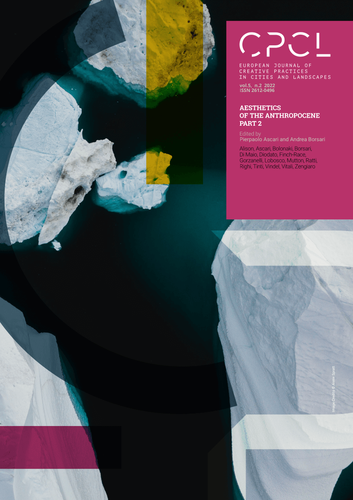
European Journal of Creative Practices in Cities and Landscapes (CPCL)
Vol. 5 No. 2 (2022): Aesthetics of the Anthropocene, Part 2
Edited by Pierpaolo Ascari, Andrea Borsari
DOI: https://doi.org/10.6092/issn.2612-0496/v5-n2-2022
Published: 2023-04-18
>https://cpcl.unibo.it/issue/view/1151
Editorial
Introduction: Aesthetics of the Anthropocene 2
Pierpaolo Ascari, Andrea Borsari 6-10
Main Section
Abysses and Ghosts. Remarks for a Discourse on Anthropocene Hyper-Aesthetics
Stefano Ascari 11-28
Perceiving the Anthropocene as a Public Health Risk via Visual Culture
Daniel A. Finch-Race 29-42
Anthropocene as Energy Imaginaries: Fossil Culture between Industrial Revolution and Ecological Crisis
Jaime Vindel 43-60
The Currency of the Anthropocene. Dismantling the Theological Presupposition of Neoliberalism in Kim Stanley Robinson’s The Ministry for the Future
Andrea Righi 61-77
Penetrating Planets: Schelling and the Anthrobscene
Francesco Di Maio 78-96
The Form of Happiness. Some Remarks on Art, Mimesis and Technology in the Wake of Adorno’s Conception of Natural Beauty
Rolando Vitali 97-114
The Assemblage as Aesthetic Place. A Reading between Aesthetics and the Anthropocene of The Mushroom at the End of the World
Ivano Gorzanelli 115-126
Soil of Enterprises. A Critical-Historical Analysis
Federico Diodato 127-144
Landscape in Transition. The Agency of Time in Understanding and Representing the Landscapes of the Anthropocene
Gianni Lobosco, Lorenzo Tinti 145-168
Aesthetics of the Anthropocene and Social Representations. A Case Study on Venice’ Exceptional High Tides in November 2019
Rebranding Athens as the Creative City of European South. The Contribution of Documenta 14. A Critical Approach
Ecosemiotics of the City. Designing the Post-Anthropocene
Practices
“Nature that Takes Back it Spaces”: when Architecture Teaches how to Trace Roots. A Conversation with Carlo Ratti
Positions
On the Aesthetics of the Anthropocene: The Sublime and beyond – other Concepts and Forms of Visualizations
Andrea Borsari 242-258
Errata
Erratum
259
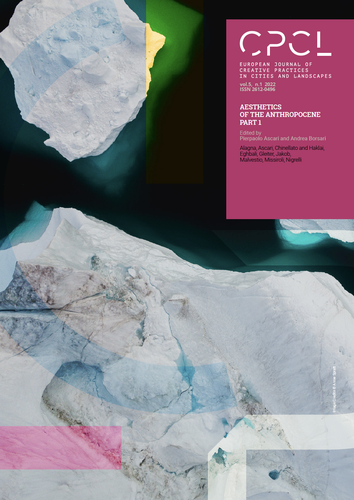
European Journal of Creative Practices in Cities and Landscapes (CPCL)
Vol. 5 No. 1 (2022): Aesthetics of the Anthropocene, Part 1
Edited by Pierpaolo Ascari, Andrea Borsari
DOI: https://doi.org/10.6092/issn.2612-0496/v5-n1-2022
Published: 2022-10-24
>https://cpcl.unibo.it/issue/view/1089
Editorial
Aesthetics of the Anthropocene
Pierpaolo Ascari, Andrea Borsari 7-10
Main Section
The Image of the World in the Anthropocene
Paolo Missiroli 11-23
Theorizing Eco-Dystopia: Science Fiction, the Anthropocene, and the Limits of Catastrophic Imagery
The Anthropocene and the Historical Index of Architecture
Inhabiting the Anthropocene. Aesthetics of Everyday Life in Times of Crisis
Houston, We Have a Problem. Sloterdijk and the Anthropocene
Mirko Alagna 64-79
Aesthetics and Dreams in the Absence of Epoch. Bernard Stiegler’s Bifurcation of the Anthropocene
Almost Black Green. On the Nineteenth-Century Park and the Naturalization of Inequalities
The Terres d’Espérances: Integration of Domestic and Green Worths into a Civic Polity
Fabien Jakob 113-131
Practices
Double Feature: Counter-Practices of World City Monumentality in the Age of the Anthropocene
Enrico Chinellato, Or Haklai 132-149
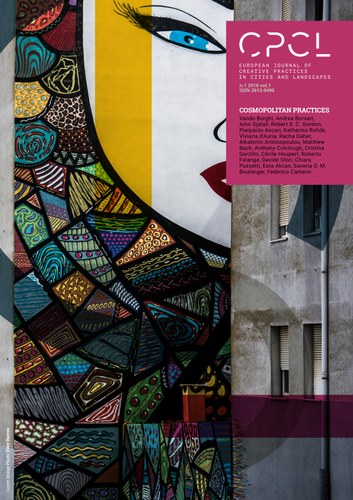
European Journal of Creative Practices in Cities and Landscapes
Vol. 1 No. 1 (2018): Cosmopolitan Practices
Edited by Vando Borghi, Andrea Borsari, Amir Djalali
DOI: https://doi.org/10.6092/issn.2612-0496/v1-n1-2018
Published: 2018-12-31
>https://cpcl.unibo.it/issue/view/753
Editorial
Cosmopolitan Practices
Vando Borghi, Andrea Borsari, Amir Djalali 1-4
Positions
Transit
Robert S. C. Gordon 5-16
Main Section
Bodies, Spaces and Citizenship: the Theoretical Contribution of Frantz Fanon
Building Cosmopolitan Citizenship Through the Mundane: Insights from Walking Conversations in the Public Spaces of Berlin
Katharina Rohde, Viviana d'Auria 33-52
Enacting Citizenship in an Urban Borderland: the Case of Maximilian Park in Brussels
Racha Daher, Viviana d'Auria 53-72
The Online Presence of Golden Dawn and the Athenian Subjectivities It Brings Forward
Practices
Temporary Permanence: the Intermittent City
Matthew Bach, Anthony Colclough, Cristina Garzillo, Cécile Houpert 93-102
Practices of Citizenship and Real Estate Dynamics: Roberto Falanga and Chiara Pussetti in conversation with Vando Borghi and Davide Olori
Vando Borghi, Roberto Falanga, Davide Olori, Chiara Pussetti 103-114
The Open Architecture To Come: an Interview with Esra Akcan
Esra Akcan, Vando Borghi, Amir Djalali 115-126
Notes
Rethinking the Smart City
Saveria Olga Murielle Boulanger 127-130
Cities Interrupted: Visual Culture and Urban Space
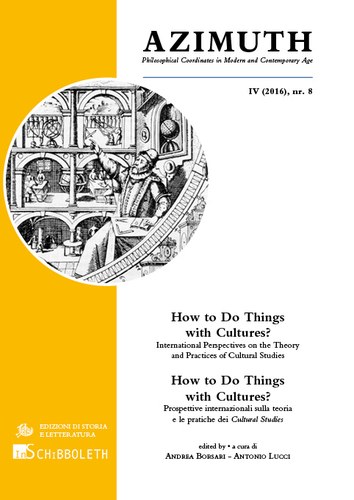
Azimuth VIII/2016: How To Do Things With Cultures?
Edited by Andrea Borsari – Antonio Lucci
ISBN: 9788893590112
>https://www.azimuthjournal.com/2017/06/04/how-to-do-things-with-cultures/
The issue explores a particular domain at the intersection of different human sciences, such as anthropology, literature, philosophy and the cultural studies. The complex constellation constituted by the – parallel and yet different – fields of the German “Kulturwissenschaften” and the Anglo-American cultural studies is inquired from two complementary perspectives: by analyzing the peculiar aspects, inner differentiations and specific focus of these two traditions, on the one side, and by exploring their mutual influence, on the other side; i.e., by considering and comparing the most important authors and consistent schools, the respective methodologies, the local manifestations as well as the historical, theoretical and thematic backgrounds of both traditions.
Contents:
Cultural Studies in Dark Times
Lawrence Grossberg
Perspektiven der Kulturwissenschaft in historischer und gegenwartsanalytischer Perspektive
Hartmut Böhme
From “Culture” to Reciprocities: Imagining the Critical Act after Power
Mena Mitrano
Italienische Kulturwissenschaft. Überlegungen zu den ‚ersten Kulturwissenschaften‘ ausgehend von der Italian Theory
Antonio Lucci
Philosophisch-anthropologische Theorien der Kultur: Cassirer, Scheler, Plessner
Joachim Fischer
Il Kulturmensch tra Tragödie e Renaissance. Estetica e antropologia nella genesi della Kulturphilosophie
Andrea Borsari
La grande dea di Efeso. Una diacronia filosofica
Giacomo Scarpelli
Le cose del Sé. Per un’archeologia della cultura (materiale)
Michele Cometa
La natura della Environmental History dopo il Cultural Turn. Temi e storiografie
Gilberto Mazzoli
Culture shakespeariane e poetica dell’emulazione
João Cezar de Castro Rocha
Appendix:
Friedrich Kittlers Nietzsche
Sandrina Khaled
Nietzsche oder die Erfindung der Kulturpolitik
Friedrich Kittler
Nodi/Symposia
Urban Aesthetics
Andrea Borsari (ed.)
in «Iride. Filosofia e discussione pubblica» II-III, May-December 2024, pp. 324-401
Index
On Urban Aesthetics
Andrea Borsari, pp: 326-345, DOI: 10.1414/116266
On Some Aesthetic Categories of Urban Experience: Surveying Conceptual Tools for an Aesthetics of the City
Nuno Fonseca, pp: 347-359, DOI: 10.1414/116267
Contemporary Forms of Urban Art and Aesthetics
Sanna Lehtinen, pp: 361-368, DOI: 10.1414/116268
Writing Urban-Aesthetics. Georges Perec and a Paris Place
Henrik Reeh, pp: 369-381DOI: 10.1414/116269
City, Architecture and Somaesthetics: a Conversation with Richard Shusterman
Aurosa Alison Andrea Borsari, pp: 383-401DOI: 10.1414/116270
Nodi
Pensare attraverso cose e immagini
Siegfried Kracauer
Borsari, Andrea, Ivano Gorzanelli (cur.),
in «Iride. Filosofia e discussione pubblica«», III dicembre 2016
Indice
«Pensare tramite le cose». L'estetica dell'attenzione di Kracauer come «fenomenologia pratica»
Dorothee Kimmich, pp: 565-578DOI: 10.1414/85112
Il cinema e l'immagine del disincanto in Siegfried Kracauer
Olivier Agard, pp: 579-590DOI: 10.1414/85113
Urban Perspectives. Siegfried Kracauer and Das Ornament der Masse
Henrik Reeh, pp: 591-604, DOI: 10.1414/85114
Figure della concretezza. Riscatto del materiale e sguardo autobiografico in Siegfried Kracauer
Ivano Gorzanelli, pp: 605-616DOI: 10.1414/85115
Per una morfologia di cose e immagini. Siegfried Kracauer e Georg Simmel
Andrea Borsari, pp: 617-634DOI: 10.1414/85116
Nodi
Adorno Centenario
Andrea Borsari (cur.)
in «Iride. Filosofia e discussione pubblica» I, aprile 2005, pp. 65-190
Indice
Adorno centenario: teoria critica e morale, ontologia e dialettica. Nota introduttiva
Andrea Borsari, pp: 65-80, DOI: 10.1414/19821
Contro la violenza etica. A partire da Adorno
Judith Butler, pp: 81-98, DOI: 10.1414/19822
Virtù e riflessione. Le "antinomie della filosofia morale" secondo Adorno
Christoph Menke, pp: 99-118, DOI: 10.1414/19823
Adorno, Heidegger e il "non" della verità
Sergio Givone, pp: 119-128, DOI: 10.1414/19824
Sul "non identico". A proposito della dialettica di Adorno
Günter Figal, pp: 129-138, DOI: 10.1414/19825
Dialettica e ontologia. Adorno e Heidegger a confronto
Lucio Cortella, pp: 139-156, DOI: 10.1414/19826
Arte fortunata - un "divertimento". Adorno, "l'arte e le arti"
Alexander García Dϋttmann, pp: 157-164DOI: 10.1414/19827
Nodi / Symposia
La miseria simbolica e la catastrofe del sensibile
Estetica, tecnica, politica in Bernard Stiegler,
Roberta Lanfredini, Claudia Nigrelli (cur.)
in «Iride. Filosofia e discussione pubblica» II, maggio-agosto 2023, pp. 255-336.
Indice
Individuale e collettivo nella teoria delle ritenzioni di Bernard Stiegler: alcune questioni aperte
Federica Buongiorno, pp: 257-274, DOI: 10.1414/112748
Filosofia della tecnica e assiologia. Su antropologia ed etica in Bernard Stiegler
Antonio Lucci, pp: 275-288, DOI: 10.1414/112749
Figure della sospensione. Una lettura della miseria simbolica
Claudia Nigrelli, pp: 289-304, DOI: 10.1414/112750
Farmacologia del divenire iperindustriale. Appunti per «biforcare» dal realismo capitalista
Giacomo Gilmozzi, pp: 305-319, DOI: 10.1414/112751
Musica, antropogenesi e individuazione. L’estetica come struttura dell’economia libidica
Edoardo Toffoletto, pp: 321-336, DOI: 10.1414/112752
Nodi / Symposia
Critical Theory and Philosophical Anthropology
Andrea Borsari (ed.)
in «Iride. Filosofia e discussione pubblica» II, maggio-agosto 2022
Strategies of Approximation: Critical Theory and Philosophical Anthropology
Andrea Borsari, pp: 291-311, DOI: 10.1414/106104
Critical Anthropology? On the Relation Between Philosophical Anthropology and Critical Theory
Hans-Peter Kruger, pp: 313-331, DOI: 10.1414/106105
Critical Theory’s Approach to Psychoanalysis: Anthropology and Primary Processes
Gerard Raulet, pp: 333-342, DOI: 10.1414/106106
On Not Saying It By Saying It: Reflections on the Category of Style in Adorno’s Aesthetic Theory
Gerhard Richter, pp: 343-357, DOI: 10.1414/106107
Nodi
Canetti politico
Andrea Borsari, Ubaldo Fadini (cur.)
in «Iride. Filosofia e discussione pubblica» III, dicembre 2010, pp. 543-630
Indice
L'antropologia politica di Elias Canetti
Olivier Agard, pp: 543-556, DOI: 10.1414/33860
Metamorfosi di Canetti
Ubaldo Fadini, pp: 557-574, DOI: 10.1414/33861
Paranoia e potere in Elias Canetti
Andrea Borsari, pp: 575-586, DOI: 10.1414/33862
I luoghi del dominio. Divieti spaziali e potere totale secondo Elias Canetti
Giorgia Serughetti, pp: 587-604, DOI: 10.1414/33863
Ethica e politica in Canetti
Francesco Saverio Nisio, pp: 605-614, DOI: 10.1414/33864
Canetti e il potere della comparazione
Eleonora de Conciliis, pp: 615-630, DOI: 10.1414/33865
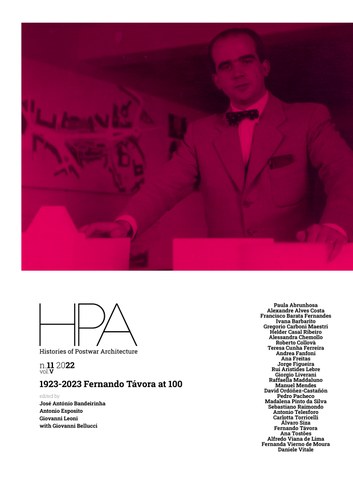
1923-2023. Fernando Távora at 100
eds. José António Bandeirinha, Antonio Esposito, Giovanni Leoni, with Giovanni Bellucci
Histories of Postwar Architecture, No. 11 (2022):
DOI: https://doi.org/10.6092/issn.2611-0075/v5-n11-2022
José António Bandeirinha, Antonio Esposito, Giovanni Leoni, with Giovanni Bellucci, The Continuous Construction of Memories/Contínua construção de Memórias de Amanhã, pp. 6-9
David Ordóñez-Castañón, Teresa Cunha Ferreira, Designing with History: Intervention in Preexisting Buildings by Fernando Távora at the Dawn of the Third Way (1945-1962), pp. 102-131
Rui Aristides Lebre, Portuguese Moderns: the Ramalde Neighborhood by Fernando Távora 1950, pp. 160-175
Fernanda Vierno de Moura, Fernando Távora and the Concept for a New Civic Centre for Aveiro: Urban Project, Modernity and the Enhancement of the Urban Landscape, pp. 176-215
Manuel Mendes, Manuel Mendes Interviews Fernando Távora. Edifícios (1988), pp. 12-39
Francisco Barata Fernandes, Outmoded Lesson, pp. 52-55
Pedro Pacheco, Ink on the Table..., pp. 56-59
Madalena Pinto da Silva, Fernando Távora: the Meaning of Time and the Reason of Things, pp. 60-67
Daniele Vitale, Távora, the Days. Távora, i giorni, pp. 68-87
Jorge Figueira, Profession: Távora, pp. 88-95
Giovanni Bellucci, Notes on the “Terceira Via” in Portugal and Sweden. A Comparison between Fernando Távora and Sven Backström & Leif Reinius, pp. 138-149
Gregorio Carboni Maestri, Fernando Távora: The Struggle from Português Suave to the Shifting Aesthetics of Resistance from 1923 to 1953. Ideology, Architectures, Periodicals, and the Role of Italy and CIAM from the First Salazar era to the Birth of the Third Way, pp. 216-255
Helder Casal Ribeiro, In the Interior of Time. Constants and Contrasts, pp. 262-273
Andrea Fanfoni, Avenida da Ponte: Knowledge of the City as a Tool for the Design of an Unresolved Place, pp. 278-299
Antonio Esposito, Fernando Távora’s Passion for the Antique, pp. 300-313
Antonio Telesforo, The “Third Way”: Távora’s Method in Masterwork. The Reconstruction of Porto’s old Municipal Tower, Known as ‘Casa dos 24’, pp. 314-363
José António Bandeirinha, A Project with Many Dates. Fernando Távora, Santa Cruz and Sansão Square in Coimbra, pp. 368-383
Carlotta Torricelli, The Pedagogical Value of the Organisation of Space. Founding Role and Continuity of Fernando Távora’s Thinking, pp. 384-405
Giorgio Liverani, Understanding Organised Space, pp. 450-485
Ana Tostões, The Search for Eternity and the Polyphony Prodigy in Távora, pp. 494-501
Giovanni Leoni, Fernando Távora and the Journey into the Constants as the Foundation of the Project (1950-1960), pp. 502-593
Raffaella Maddaluno, A Travel in Fernando Távora’s Travels. (With Álvaro Siza, Alexandre Alves Costa, Fernando Barroso, Sérgio Fernandez, Alcino Soutinho, Manuel Mendes, José António Bandeirinha, Jorge Figueira, Francisco Barata, Eduardo Souto de Moura, 2013-2022), pp. 594-635
Paula Abrunhosa, Dialogues with Memory and Time: A Contribution by the Marques da Silva Foundation for the Promotion of Fernando Távora’s Archive, pp. 636-649
Ana Freitas, The Travel Drawings of Fernando Távora: a few Brief Notes on their Exhibition and Conservation, pp. 650-659
Alexandre Alves Costa, A Statement without Rhetoric About the Architect Fernando Távora/Depoimento sem retórica sobre o Arquiteto Fernando Távora, pp. 40-51
Fernando Távora, O problema da casa portuguesa, pp. 96-101
Alfredo Viana de Lima, Fernando Távora, Between Sigtuna (1952) and Royaumont (1962), pp. 132-137
Giovanni Bellucci, Ramalde Housing Estates, pp. 150-153
Giovanni Bellucci, Renovation of Aveiro City Centre, pp. 154-159
Giovanni Bellucci, Pousada Santa Marinha da Costa, pp. 256-261
Giovanni Bellucci, Renovation of the Former Council Building – Casa dos Vinte e Quatro, pp. 274-277
Giovanni Bellucci, Arrangement of 8 de Maio Square, pp. 364-367
Fernando Távora, Architecture and Urbanism. The Lesson of Constants, pp. 406-409
Fernando Távora, Le Corbusier, Bruno Zevi, Lúcio Costa, pp. 410-423
Giovanni Bellucci, House on the Sea, pp. 424-425
Giovanni Bellucci, City Market, pp. 426-429
Giovanni Bellucci, City Park of the Quinta da Conceição e de Santiago, pp. 430-436
Giovanni Bellucci, Tennis Pavilion in the “Quinta da Conceição” City Park, pp. 438-441
Giovanni Bellucci, Holiday Home in Ofir, pp. 442-445
Giovanni Bellucci, Aula Magna - Faculty of Law, pp. 446-449
Álvaro Siza, A Dialogue On-Site with Álvaro Siza, pp. 486-493
Roberto Collovà, Architecture of Photography, pp. 660-669
Alessandra Chemollo, The Concept Fragment, pp. 670-679
Ivana Barbarito, The Photographer Never Turns a Blind Eye, pp. 680-685
Sebastiano Raimondo, A Look at Fernando Távora’s Quinta da Conceição, pp. 686-693